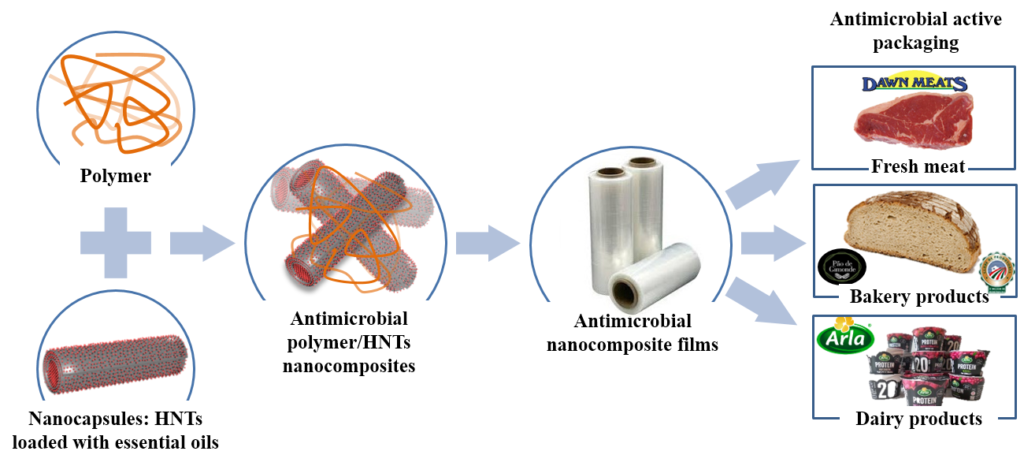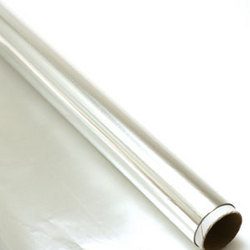Pilot line manufacturing of functional polymer nanocomposites from natural halloysite nanotubes: demonstrating controlled release of active antimicrobials in food packaging applications
NanoPack aims to develop and demonstrate state-of-the-art antimicrobial packaging solutions for perishable foods based on natural nanomaterials that will prevent food-borne illness outbreaks and reduce food waste caused by early spoilage.
NanoPack will help reduce the staggering 1.3 billion tonnes of food wasted each year, which cause major economic loss and significant harm to the world’s natural resources. The project intends to present better performing, safer and smarter products that will position Europe as the leader in food nanotechnology and smart antimicrobial packaging while increasing competitiveness and growth.
The active polymer films developed by NanoPack exhibit broad-spectrum antimicrobial properties unmet by existing state-of-the-art materials, which include currently used nanomaterials such as silver particles, which have raised health concerns of toxicity and microbial resistance. Applying the power of nanotechnology, the project will employ polymer composites based on natural Halloysite Nanotubes (HNTs) as reliable and safe carriers, capable of tailored release of bioactive payloads. Due to their size, HNTs are unable to migrate from the food packaging into food. Maximizing safety, HNTs in the NanoPack food packaging slowly release minute amounts of potent, volatile, natural and EU-approved essential oils into the packaging headspace. The oils exhibit both antimicrobial and anti-fungal properties and can be tailored to inhibit growth of most food-borne microbes.

NanoPack schematic
The three-year project is aimed at demonstrating, validating and testing food-packaging products with antimicrobial surfaces based upon natural materials. NanoPack will address scientific, technological, economic, safety and regulatory challenges to ensure that consumers eventually will be able to benefit from this novel packaging.
NanoPack intends to develop, scale up and run pilot lines in operational industrial environments to manufacture antimicrobial polymer films that are commercially feasible and accepted by retailers and consumers alike.
ACTIVITIES of Bio Base Europe Pilot Plant
- Scale-up of the Halloysite Nanotubes (HNT) loading process with active compounds (essential oils)
- Scale-up of the HNT functionalization process
- Optimising formulation of HNTs to enable easier integration during large scale compounding
- Demonstration of the production of kilograms loaded HNTs allowing the production of > 2000 m² of plastic film
PARTNERS
Coordinator:
Technion – Israel Institute of Technology, IL: Project Coordinator; Loading active agents into halloysite nanotubes (HNTs); efficacy testing
Industrial partners:
- Bio Base Europe Pilot Plant, BE: Scale up and industrializing HNTs loading process; manufacturing loaded HNTs (nanocapsules)
- Carmel Olefins Ltd., IL, Bazan Group: Incorporation of loaded HNTs (nanocapsules) within polymers and polymer nanocomposites production
- Constantia Flexibles International, AT: Large pilot line manufacturing of flexible food packaging
- Tommen Gram, NO: SME pilot line manufacturing of flexible food packaging
- AIDISA, ES: Laboratory testing of packaging on various food products; Communication & Technology transfer to other players in food industry, especially SMEs
- Dawn Meats, IE: Large pilot line production of packaged meat products
- Arla Foods, DK: Large pilot line production of packaged dairy products
- Pão de Gimonde, PT: SME pilot line production of packaged bakery products
- Vertech, FR: Life cycle assessment, Environmental analysis, Cost base analysis
RTD Partners:
- Fraunhofer-Gesellschaft IAP, DE: Surface treatment of nanotubes; tailoring the interfaces of nanocapsules and polymers; Fraunhofer-Gesellschaft IVV, DE: food regulatory assessment
- DHI, DK: Department of Environment and Toxicology. Regulation (nanomaterials and food packaging materials), consumer safety and ecotoxicological characterization of nanomaterials
- National Research Centre for the Working Environment, DK: Occupational assessment focusing on inhalation toxicology and physicochemical characterisation of nanomaterials
Demand Side Partners – Linking with consumers, SMEs, packaging & food industry, academia and retailers:
- Active & Intelligent Packaging Association, NL: Communication & Technology transfer to other players in the packaging industry, especially SMEs
- European Food Information Council, BE: Consumer research (acceptance of novel technologies);Communicating with EU & global consumers; knowledge on food safety & risks
- European Federation of Food Science and Technology, NL: Communication & Technology transfer to other players in food industry, especially SMEs; food science & technology experts
- Aarhus University MAPP Center, DK: Retailer and consumer behaviour studies
Project Management:
Agora Partners, IL: Management; Dissemination, Communication & Visibility
SUPPORTED by:
This project has received funding from the European Union’s Horizon 2020 research and innovation programme under grant agreement No 720815.



 webdesign
webdesign